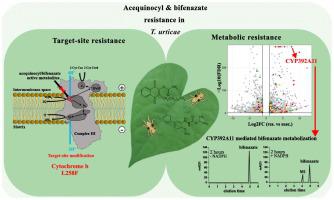Pesticide Biochemistry and Physiology ( IF 4.2 ) Pub Date : 2023-03-24 , DOI: 10.1016/j.pestbp.2023.105411 Xueping Lu 1 , Marilou Vandenhole 1 , Dimitra Tsakireli 2 , Spiros A Pergantis 3 , John Vontas 2 , Wim Jonckheere 1 , Thomas Van Leeuwen 1

|
Acequinocyl and bifenazate are potent acaricides acting at the Qo site of complex III of the electron transport chain, but frequent applications of these acaricides have led to the development of resistance in spider mites. Target-site resistance caused by mutations in the conserved cd1- and ef-helices of the Qo pocket of cytochrome b has been elucidated as the main resistance mechanism. We therefore monitored Qo pocket mutations in European field populations of Tetranychus urticae and uncovered a new mutation, L258F. The role of this mutation was validated by revealing patterns of maternal inheritance and by the independently replicated introgression in an unrelated susceptible genetic background. However, the parental strain exhibited higher resistance levels than conferred by the mutation alone in isogenic lines, especially for acequinocyl, implying the involvement of strong additional resistance mechanisms. This was confirmed by revealing a polygenic inheritance pattern with classical genetic crosses and via synergism experiments. Therefore, a genome-wide expression analysis was conducted that identified a number of highly overexpressed detoxification genes, including many P450s. Functional expression revealed that the P450 CYP392A11 can metabolize bifenazate by hydroxylation of the ring structure. In conclusion, the novel cytochrome b target-site mutation L258F was uncovered in a recently collected field strain and its role in acequinocyl and bifenazate resistance was validated. However, the high level of resistance in this strain is most likely caused by a combination of target-site resistance and P450-based increased detoxification, potentially acting in synergism.
中文翻译:

新陈代谢增加与新型细胞色素 b 靶位点突变 L258F 相结合,赋予 Tetranychus urticae 中 Qo 抑制剂乙酰喹啉和联苯那酯之间的交叉抗性
Acequinocyl 和 bifenazate 是有效的杀螨剂,作用于电子传递链复合物 III 的Q o位点,但这些杀螨剂的频繁应用已导致叶螨产生抗药性。由细胞色素b的 Q o口袋的保守 cd1-和 ef-螺旋突变引起的靶位点抗性已被阐明为主要的抗性机制。因此,我们监测了Tetranychus urticae欧洲野外种群的Q o pocket 突变,并发现了一个新突变 L258F。这种突变的作用通过揭示母系遗传模式和独立复制的在不相关的易感遗传背景下的基因渗入。然而,亲本菌株表现出比同基因系中单独突变所赋予的更高的抗性水平,尤其是对乙酰喹啉,这意味着强的额外抗性机制的参与。通过揭示具有经典遗传杂交的多基因遗传模式和通过协同作用实验证实了这一点。因此,进行了全基因组表达分析,确定了许多高度过表达的解毒基因,包括许多 P450。功能表达表明 P450 CYP392A11 可以通过环结构的羟基化代谢联苯那酯。总之,新型细胞色素b在最近收集的野外菌株中发现了目标位点突变 L258F,并验证了其在对乙酰喹啉和联苯那酯抗性中的作用。然而,该菌株的高水平耐药性很可能是由靶位点耐药性和基于 P450 的解毒作用增加共同引起的,可能具有协同作用。
















































 京公网安备 11010802027423号
京公网安备 11010802027423号